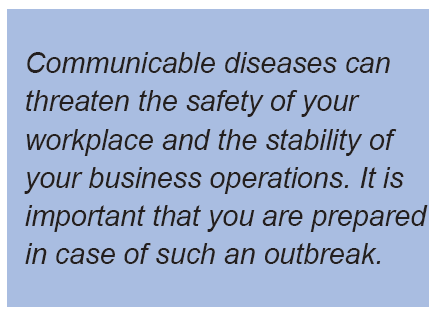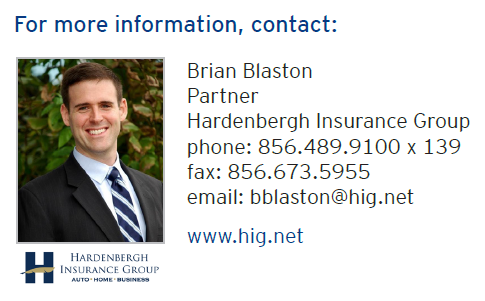 Let’s look at Avoiding the Spread of Communicable Disease in the Office. As a risk manager, it is important to be prepared for any number of events that could threaten the safety of your employees and/or cause severe business interruption. One of these threats is a communicable disease. Communicable diseases are ones that
Let’s look at Avoiding the Spread of Communicable Disease in the Office. As a risk manager, it is important to be prepared for any number of events that could threaten the safety of your employees and/or cause severe business interruption. One of these threats is a communicable disease. Communicable diseases are ones that
are easily transmitted among people, and include influenza, hepatitis, tuberculosis, HIV and many others. If one of your employees contracts such an infectious disease or there is an outbreak in your local community, you need to be prepared to maintain as safe and healthy a workplace as possible.
5 Factors in Avoiding the Spread of Communicable Disease in the Office
Download Printable Article (PDF) >>>
REQUIRED EMPLOYEE DISCLOSURE
At the most basic level, organizations should develop a communicable disease policy in the workplace requiring employees to notify the company of any possible exposure to certain diseases. This will allow the organization to take proactive preventive measures against the spread of the disease. Since medical disclosures are governed by the Americans with Disabilities Act (ADA), employers must ensure that the policy meets the requirements of the ADA, including keeping employee health information confidential as required by the Health Insurance Portability and Accountability Act (HIPAA). As part of the policy, employees may be asked to work reduced hours, work from a remote location and/or may be removed from nonessential job duties until they are no longer contagious.
TRAVEL AND QUARANTINE POLICIES
Employee travel must comply with all advisories from the CDC and U.S. Department of State. As a result, those who are traveling to areas with current communicable disease outbreaks must obtain all recommended vaccinations and follow all health recommendations.
If an employee travels to a region of the world for which he or she must be quarantined upon arrival back to the United States, he or she should notify immediately to arrange for telecommuting or paid leave. This policy should be communicated to employees prior to any travel taking place.
EMPLOYEE LEAVE POLICIES
Social distancing is one of the best methods to prevent the spread of a communicable disease in office. Employees may be subject to quarantine, may be ill and need to stay home, or may be home caring for sick relatives. As a result, these individuals should remain away from the workplace to reduce the likelihood of infecting others.
Beyond this, other employees may fear that they will come in contact with a disease while being in the workplace and may consequently refuse to come to work. In response, should consider devising policies to address these concerns and leave issues. These policies may include the following:
• Compliance with the directives of the CDC with regard to social distancing
• Maintenance of company operations, including backup options for essential supply chains, business functions and personnel
• Sustaining a functioning workforce to minimize the effects of employee absenteeism
• Limiting unnecessary social interaction. This may include avoiding in-person meetings and instead utilizing e-mail, telephone or other remote conferencing strategies
• Compliance with applicable laws, including the Family and Medical Leave Act (FMLA) and the Uniformed Services Employment and Reemployment Rights Act (USERRA). Also compliance with overtime stipulations of the Fair
Labor Standards Act for telecommuting employees
• Address the following logistical concerns:
• How employees request communicable disease leave
• Requirements for regularly reporting medical conditions
• Whether leave is paid or unpaid
• Whether benefits are provided or accrued during the leave period
• If leave becomes exhausted, whether employee will be required to return to work
FEDERAL COMPLIANCE
In addition to the laws mentioned above, there are other laws that may affect a policy regarding communicable disease in the office nd its ramifications:
• The Privacy Rules under HIPAA require employers to protect the privacy of all employee medical information. As a result, employers must determine what diseases employees must report, who will have access to this information and whether reporting this information to public health officials is necessary. If other employees must be notified of a possible communicable disease case in the workplace, all necessary precautions must be taken to protect the privacy of the infected individual.
• Under FMLA, for employers with 50 or more employees within a 75-mile radius, employees who have worked for the company for 12 months and have worked 1,250 hours within the last 12 months are entitled to up to 12 weeks of unpaid leave due to a “serious health condition.” Most communicable diseases will likely be considered applicable under this regulation.
• An employee who suffers a permanent health problem that greatly affects his or her daily life may be entitled to protection under the ADA.
• Under the Employee Retirement Income Security Act of 1974 (ERISA), employers must confirm that employees under their health plan receive an updated summary plan description (SPD) of the health benefits. If employees do not receive an SPD, the provisions allowing the plan to change may not be enforceable. Furthermore, if an employer cannot prove that employees and/or dependents did receive a revised SPD, then the employer may be required to provide higher benefits in accordance with previous SPDs.
COMMUNICABLE DISEASE RESPONSE PLAN
Creating a communicable disease response plan is an effective way to communicate with employees clearly
while also complying with local, state and federal guidelines for pandemic responses. Plans should be concise, easy to understand, and effective in preserving the health and safety of all employees. Plans should include the following:
• The designation of a person within the workplace who is responsible for all disease planning and emergency actions
• Communication of the policy and required steps for requesting leave
• Development of protocol with regard to increased absenteeism and how to maintain a functioning workforce
• Development of a monitoring program to track employees who cannot return to work immediately due to illness
• Development of social distancing strategies to limit transmission risks
• Plan distribution timeline and format (online, hard copy, etc.)
In disease outbreak situations, it is important that employers are prepared and remain flexible in their response strategies, in order to maintain critical business operations while also keeping their employees safe and healthy.



